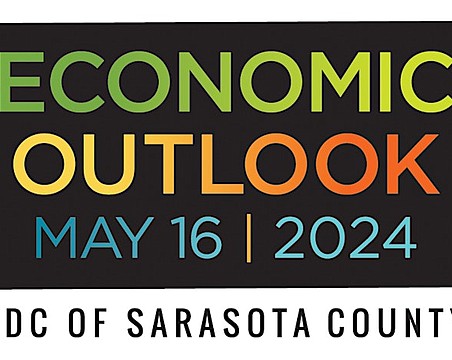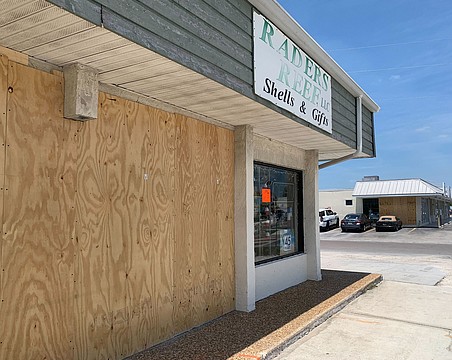Economic Blessing?
Hurricane Charley may have destroyed or forced the closure of only 1% to 5% of businesses in its path. That's much less than the damage Andrew caused in 1992.
By David R. Corder
Associate Editor
Three years ago, a Milken Institute survey in Forbes magazine bestowed an honor on the Charlotte County community of Punta Gorda. It ranked the Southwest Florida area as fifth in the nation as the "Best Small Place for Business and Careers." Two years earlier, Money Magazine ranked the region as the nation's No. 2 area for future job growth.
Such accolades fueled local optimism for short- and long-term economic growth and opportunities. Then on Aug. 13 Hurricane Charley dealt Punta Gorda and Port Charlotte, as well as the nearby Fort Myers-Cape Coral area, a serious economic setback as the storm possibly became the second costliest hurricane in U.S. history.
Only the human misery left in the hurricane's aftermath eclipses the impact on the local economy. The storm's true economic impact remains a matter of speculation, at least for now, as local officials assess losses.
"You just don't know how it's going to affect the market," says Charlotte County Property Appraiser V. Frank Desguin.
But the economic lessons learned 12 years ago in the aftermath of Hurricane Andrew, the nation's costliest hurricane, offer some insight into what these communities might experience over the coming months and years.
Early insurance industry reports put losses at as high as $14 billion on the damage Charley caused as it traveled up the Gulf Coast into Central Florida en route to the Eastern Seaboard. That may be an excessive estimate, however. Risk Management Solutions puts the figure closer to $5 billion in insured losses.
Such revised estimates tell New York economist Robert P. Hartwig the Punta Gorda-Port Charlotte and Fort Myers-Cape Coral metropolitan statistical areas may fare far better economically than the insurance industry originally feared. Hartwig studies the economic impacts of business closures in hurricane-prone counties as senior vice president and chief economist for the Insurance Information Institute.
Two years ago, Hartwig published a report about the impact of Hurricane Andrew on business closures in Miami-Dade, Broward and Monroe counties. Official estimates showed Andrew destroyed or forced the closure of 10% of all the businesses in Miami-Dade, the county hardest hit. Using the storm as a bellwether, he calculated estimated potential single-year, post-event losses on business sales, sales tax, payroll and jobs for the counties of Broward, Miami-Dade, Hillsborough, Lee, Monroe and Palm Beach. He then calculated losses on a scale of 1% to 15%.
Hartwig suspects Charley may have destroyed or forced the closure of 1% to 5% of the businesses in the storm's path. He says Charlotte and Lee counties would bear the largest share of the closures.
"It does not look like Charley had a lasting impact on business as going concerns," Hartwig says. "So I would expect a number even less than 5% of what would shut down for an extended period of time."
Assuming a 3% loss in just Lee County, Hartwig projects the loss of 241 businesses, $300 million in lost sales, $11.2 million in lost sales taxes, $68 million in payroll losses, 3,091 lost jobs and total dollar losses of about $379 million.
While Hartwig did not focus on Charlotte County, the U.S. Census Bureau in its 2001 survey of County Business Patterns listed 3,149 business establishments in that county. So a 3% destruction or closure of businesses there could impact about 94 companies.
Hartwig says the storm did not cause as much damage as Andrew. He attributes that to a compact storm center that extended somewhere between six to 10 miles, perhaps even less. Andrew left a swath about 30 miles wide.
"The brunt of the damage seems to have occurred to residential structures," he says.
It's also unlikely Charley poses long-term negative impacts on local industries such as retail or tourism, Hartwig says. Tourism has a direct and indirect economic impact of about $304 million a year in Charlotte County, the Charlotte County Visitors Bureau reports. Retail, however, accounts for about 22% of all jobs in the county, Census Bureau data shows. Of the eight largest private employers in the county, five are retailers - Publix Supermarkets, 1,175 workers; Wal-Mart Stores Inc., 954 workers; Winn-Dixie Inc., 587 workers. Two of the eight are health care providers, including the largest employer, Bon-Secours-St. Joseph, with 1,251 workers.
The same is somewhat true for Lee County, where retail jobs account for about 20% of all jobs. However, few of Lee's largest private employers are retailers. The largest, Interstate Hotels & Resorts, operates a call center, with 1,413 workers; Yoder Brothers, a flower grower, 690 workers; Sony Electronics, which staffs a customer service and technical support operation, 636 workers.
"It's unlikely Charley has significantly disrupted the tourism industry as Andrew did," Hartwig says. "It does not appear we have situations where there are completely collapsed hotels.
"It also looks like most of those businesses in these areas will be able to reopen within a reasonable amount of time," he adds. "The winds were simply not as strong as Andrew."
Short-term impact
Charley's impact on the labor market may pose one of the more serious problems for businesses in Charlotte and Lee as owners rebuild. In 1992, for instance, a significant number of people fled the damage zone for a variety of personal and economic reasons.
"In terms of trying to estimate the short-term or the long-term impact of (Charley) on the population in those two counties, no, it's way too early," says economist Stanley K. Smith, director of the Bureau of Economic & Business Research at the University of Florida. "In the previous storm (Andrew), it was several years before we had any sort of any sort of clear picture."
"A shift is possible," he adds. "Again, until we have some data to reflect what happens, it's impossible to form any judgment as to how large of an impact that will be. It would be a pure stab in the dark, and I don't like to do that."
The state Agency for Workforce Innovation anticipates 48,000 new unemployment claims because of Charley. But the agency expects that figure to climb as high as 120,000 as companies elsewhere cut back production because of diminished demand for supplies and services in Charlotte and Lee and other counties affected by Charley's rampage.
Such new numbers of unemployed workers also could impact the labor markets in neighboring counties such as Collier, Hillsborough, Pinellas, Pasco and Polk as the unemployed try to rebuild their lives.
In a 1996 study, Smith concluded that Andrew temporarily displaced about 350,000 people. Of that number, 30,000 moved to Broward. Another 30,000 relocated to elsewhere in Florida. About 18,000 people left the state, though he thinks most eventually returned.
"Our final conclusion was that about 40,000 left the county permanently; that the population was 40,000 less than it would have been in a county of about 2 million people," he says. "By the end of the two-year period, most of the moving around as a result of the hurricane had been completed."
In Lee, nearly 35% of the population is over age 65. The storm could have a particular impact on this market segment, which is accustomed to comfortable sedentary lifestyles. Now they face days or weeks of survival in Florida's heat without air-conditioning and amid mosquito swarms, while struggling to meet basic human needs.
Even if a portion of that population group flees in the short-term, their flight probably won't have a long-term impact on the Charlotte and Lee economies. In Smith's study, he concluded Andrew only caused a blip on the population curve. "In (Miami-Dade) County, over the past 10 years, growth has been increasing. There is no lingering impact of the storm."
Winners, losers
By studying Andrew's aftermath, Shahid Hamid found convincing evidence about who wins and who loses following such catastrophes. He studies the financial and insurance consequences of natural disasters as an associate professor of finance in the College of Business Administration at Miami's Florida International University.
"Minorities in the poorest communities are the losers," Hamid says. "It's easier for the middle class in those areas to pick up and move; whereas the poorer population cannot do so as readily.
"Particularly in certain areas, the lower income areas did not rebuild," he adds. "They didn't get the funds the other areas did because their insurance coverage was low. They never really recovered to the pre-Andrew level."
Such storms also have a considerable impact on small businesses, Hamid says, adding, "Small businesses, mom-and-pop shops, were hurt, no doubt about it. Some of them did not rebuild because they lost customers."
But Hamid also expects Southwest Florida to experience some benefits from Charley.
"Basically, as is well known now, there is a fairly positive impact on the economy, because of the inflow of funds from the federal government, the insurance industry and the state government," he says. "So you'll have sort of a boom for a while in the construction industries. Retail will boom. There are stories how retail sales jumped dramatically in the months after Andrew. So sales taxes went up, too."
With the inflow of insurance proceeds, Hamid says, the real estate and the construction industries benefit as homeowners and business owners rebuild.
"There were short-term impacts - a shortage of housing," he says. "So rental prices went up significantly. But even in the worst hit areas, it was all rebuilt, except for Homestead, which didn't recover from a business extent."
Because of the storm damage, Hamid says, property owners in hurricane-damaged areas should anticipate a temporary decrease in property values. Property values bottomed out by '93-'94 in south Miami-Dade.
"Since '94, property values have been rising pretty consistently," he says. "So real estate was not really affected. ¦ In fact, it certainly had some positive impact on the growth of the industry."
With that concern in mind, Desguin plans to ask Gov. Jeb Bush to grant relief to Charlotte County residents and businesses from property tax bills now due. He expects Charley to have only a short-term impact on the county's overall assessed market value of about $17.5 billion.
"We're going to see how it pans out through December," he says. "All the properties damaged as of Jan. 1 will certainly affect the value next year. But you could have some of the properties repaired by Jan. 1."
Meanwhile, Hamid wonders about the potential impact of Charley on residential and commercial property and casualty insurance rates.
"Insurance rates have gone up dramatically," Hamid says. "That's probably the most significant long-term impact (of Andrew). You could argue the rates would have been too low before Andrew, but that's a matter of debate."
The storm's impact on the insurance industry won't be known for quite some time, says Jack E. Nicholson, senior officer of the Florida Hurricane Catastrophe Fund, created by lawmakers in 1993 to offset the impact of hurricane damage on insurers. The state agency sent out a preliminary inquiry to the 229 insurance companies that participate in the hurricane loss fund to get a better idea of Charley's damage, Nicholson says. But that report won't be ready for about two weeks.
As of Aug. 17, Nicholson says, some insurance industry forecasts put Charley's insured losses at between $5 billion to $9 billion. He is optimistic, however. "Those numbers may be way overstated," he adds.
Estimated value of hurricane destruction
or closure of business establishments*
CountyEstablishment lossSales lossTax lossPayroll lossJob lossTotal losses
Broward3,063$5.3 billion$135 million$1.2 billion44,079$6.6 billion
Miami-Dade4,918$7.7 billion$164 million$1.6 billion60,072$9.5 billion
Hillsborough1,842$3.9 billion$96 million$853 million33,512$4.9 billion
Lee802$999 million$37.3 million$226 million10,303$1.3 billion
Monroe254$274 million$12 million$45 million2,369$331 million
Palm Beach2,543$3.1 billion$100 million$863 million31,280$4.0 billion
*Table represents 10.1% loss of all sales, sales tax, payroll and jobs - a situation comparable to what happened in 1992 when Hurricane Andrew struck Miami-Dade County.
Source: "Florida Case Study: Economic Impacts of Business Closures in Hurricane Prone Counties," published in June 2002, by Robert P. Hartwig, Ph.D, senior vice president and chief economist, Insurance Information Institute.





